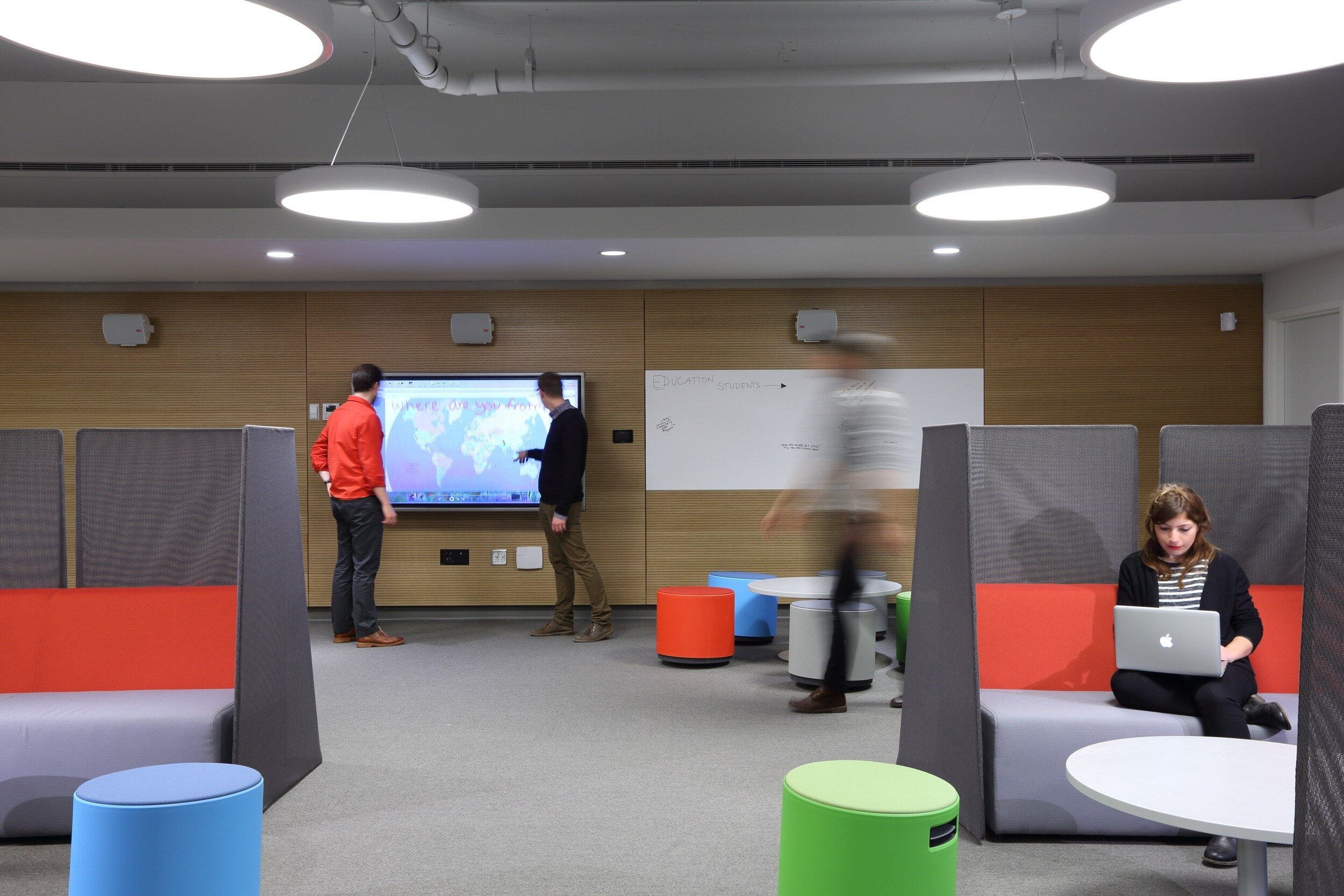Updated April 1, 2023 | Reviewed by Sam Scott
Education has come a long way since the days of one-room schoolhouses and chalkboards. Over the years, classrooms have evolved from static spaces with rows of desks to dynamic environments that foster collaboration, creativity, and engagement.
The shift from teacher-centered instruction to student-centered learning has been transformative, putting the focus on the educational needs and interests of each pupil.
In this article, we'll explore the future of learning spaces and how AV technology is at the core of modern classroom designs that support collaborative learning.
The Classroom Concept Is Evolving
The traditional classroom layout, with desks arranged in rows facing the front of the room, is becoming a thing of the past. Instead, modern classroom design emphasizes collaborative learning spaces that encourage student interaction and engagement.
These spaces often feature movable furniture, shared whiteboards, and AV technologies such as projectors, video screens, and videoconferencing systems. These technologies make it possible for students to participate in remote learning, collaborate on projects, and share ideas freely.
To facilitate remote learning, schools need to provide students with access to learning materials from anywhere in the world. And with the rise of online and hybrid attendance, educational institutions and their instructors must embrace a new approach to equitable and inclusive participation.
By allowing both distributed and in-person students to learn in a more interactive and immersive manner, the modern classroom supports a constructivist approach to developing knowledge through experience, leading to better information retention.
AV Technology Is Driving Change
The evolution of the modern learning space would not be possible without AV technology, which continues to play a critical role in the transformation of campuses and classrooms.
AV design consultants regularly work with educators to create learning hubs that provide students with access to the latest technology. By helping project leaders define their desired outcome and identify the right products to achieve it, AV consultants ensure that learning spaces meet the unique needs of each institution.
AV also plays a crucial role in shaping the future of distance learning. The COVID-19 pandemic forced many schools to embrace remote learning in 2020, and audio visual technology helped students carry on with their studies despite gathering restrictions.
Since the pandemic, demand for online learning has continued to grow — along with the expectations of a quality distance education. As a result, institutions continue to seek audio visual classroom improvements that support remote participation and deliver a distinctive experience for online course offerings.
The Rise Of Video-Based Learning
One key area where AV technology significantly impacts education is through video. As more institutions move toward hybrid or online learning, video streaming becomes an essential component of learning space design.
According to eLearning Industry, video streaming is the future of education. The ability to stream lectures and other content makes it possible for students to access educational materials from anywhere, at any time. Educators can reach a broader audience and provide flexible online learning opportunities. Further, by enabling remote students to participate in real-time, the technology allows for increased collaboration and engagement.
Effective classroom video streaming requires careful planning and a robust technology infrastructure. AV consultants can help institutions implement video-based learning by identifying products and software that suit user needs, overseeing the installation, and training faculty and staff on how to use the system effectively.
Once made a necessity by the pandemic, real-time remote participation now allows educators to reach a broader audience.
Collaborative Learning Spaces Are Key
Learning space design has a significant impact on the student experience. In flexible and adaptable environments that encourage group work and active participation, learners become better equipped to develop critical thinking, communication, and motivational skills that will serve them well in future careers.
The design of learning spaces can inhibit or enhance the collaborative learning experience, so it’s important to get things right or you risk wasting your investment. Collaborative learning spaces should be designed to promote student engagement, communication, and participation. Tools such as interactive displays, media switches, and wireless presentation systems help satisfy these objectives and make it easier for students to work together.
Case Study: Collaborative AV Switching Systems At The University of Manchester
The Manchester Engineering Campus Development (MECD) is the University of Manchester’s premier initiative to cultivate the engineers and innovators of the future. As one of the largest construction projects launched by a UK higher education institution, the MECD seeks to revolutionize how engineers are educated by fostering collaboration and promoting progressive research techniques.
As part of the MECD project, the university sought to standardize and link hundreds of flexible learning spaces across its new and existing buildings. After engaging an AV design consultant, they were quickly paired with an AV manufacturer that could provide the necessary equipment to satisfy the project’s needs and integrate with existing systems.
Now, the University of Manchester has been transformed into an enormous, flexible learning space as audio and video can be sent from any one room to another.
See this educational AV case study to learn more.
Case Study: Collaborative Classrooms At Simon Fraser University
At Chroma, we've had the opportunity to work with several educational institutions to design and implement modern audio visual classrooms. One example is a 2016 project with a university that wanted to create a collaborative learning space that could accommodate different teaching styles and facilitate student engagement.
Our principal AV consultant, Sam Scott, worked closely with Simon Fraser University's faculty and staff to understand their project goals. Sam recommended an AV solution that included interactive displays, multi-device connectivity, and distributed speakers. Sam also designed and implemented a comprehensive control system, providing the flexibility to change class sizes.
The result was a cutting-edge AV learning hub that allowed instructors to use a wide range of teaching styles, from traditional lectures to interactive group projects. The “flipped classroom” concept was a hit with students and staff, who appreciated the ability to configure the various learning spaces from the IT help desk.
Learn more about the Collaborative Classroom project at Simon Fraser University.
The Future of Learning Spaces
In the future, learning spaces will be even more dependent on AV than they are today. As technology continues to evolve and improve, institutions will be able to create more dynamic and engaging educational environments that can better prepare students for their careers.
Here are some key trends that are likely to shape the future of education, courtesy of EdTech Magazine:
Expanded Use of Digital Learning Tools: During the pandemic, instructors used video collaboration tools because they had to. But now that those tools have become the norm and instructors are more familiar with the technology, they will embrace additional features that enhance interactivity, such as mobile polling and video annotation.
Improved In-Person Experiences: Hybrid participation is here to stay, but that doesn’t mean everyone’s remote environment is an ideal learning space. Institutions will seek to enhance and demonstrate the value of the in-person experience with flexible, AV-enabled classrooms that entice students to make the trip.
Virtual Reality and AI: We don’t know precisely how the use of VR and AI in education will play out, but these technologies’ falling costs (in the case of VR) and widespread adoption (in the case of AI) suggest their disregard will be at an educator’s peril. In the case of AI, where plagiarism may be unfeasible to detect, educators must fundamentally reassess how they evaluate student performance.
The future of learning spaces is bright, and audio visual technology will play a significant role in shaping how students learn for years to come. We expect educational institutions to continue implementing modern classroom concepts that accommodate different teaching styles, promote student engagement, and provide the best possible learning experience.
At Chroma, we are committed to helping you stay ahead of the curve regarding campus technology and educational AV. Whether you need help designing a new learning space or upgrading an existing one, we have the expertise and experience to guide your project to success.
Contact us today to discuss how you can create a collaborative learning space that fosters creativity, critical thinking, and teamwork.
FAQs
How are classrooms evolving?
Classrooms are evolving from traditional layouts with rows of desks into collaborative learning spaces that emphasize student interaction and engagement.
How is video-based learning impacting education?
Video streaming technology makes it possible for students to access educational materials from anywhere, at any time, enabling remote students to participate in real-time.
Why are collaborative learning spaces important?
Collaborative learning spaces that encourage group work and active participation help learners develop critical thinking, communication, and motivational skills that will benefit their future careers.
What trends are shaping the future of education?
Some key trends likely to shape the future of education are expanded use of digital learning tools, improved in-person experiences, and increased use of virtual reality and AI.



